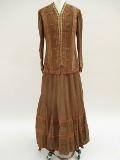The main fabric of this two-piece ensemble, c. 1908-1910, is a loosely woven 100% wool. The jacket is flat-lined with tissue weight silk and then lined with a heavier silk. The trim is bias, cut from the same silk used to line the jacket. The flange at center front is gold bullion ribbon.
Overview
The main fabric of the ensemble is a loosely woven 100% wool. The jacket is flat-lined with tissue weight silk and then lined with a heavier silk. It is interfaced with a polished linen and has wool felt shoulder pads, as shown in the Figure 1 below. The trim is bias, cut from the same silk used to line the jacket. The flange at center front is gold bullion ribbon. The skirt is unlined. The seams on the inside are bound with silk or cut on the selvage.
The overall condition of the dress is fragile. The fashion fabric has some moth holes scattered about the entire surface of the skirt and jacket. The lining is completely disintegrated and fallen away in pieces from the jacket. The buttons are covered in silk, but some have become bare; two of them are missing from the back of the jacket. At the center back of the jacket a small piece of lining remains holding a label which as been cross stitched in. The label states "O'Neill's Baltimore."
|
Figure 1: Shoulder pads and label |
 |
Jacket Construction
The jacket is constructed of eight panels, front, side front, side back and back, with a seam down center back. The shoulder seams have been dropped down in the back. The body of the jacket is flat lined, but the sleeves are not. Both the sleeves and the body are fully lined. The interfacing extends the full length of center front. It goes through the shoulder and around the back of the neck, encompassing the entire armseye as well. An additional piece of stiffened interfacing is in the center front flange. The photo to the left below (Figure 2) is an inside view of center front to side front showing the shape of the interfacing and the reinforced flange. The center front butts together and closes with hook and bar closures.
There are two vents at the side back seams of the jacket; each is 5" long and laps 1". The image below at right (Figure 3) shows the back vent held open exposing a four-ounce weight. There are eight weights around the hem of the jacket.
|
Figure 2: Inside center front |
Figure 3: Inside center back vent with weight |
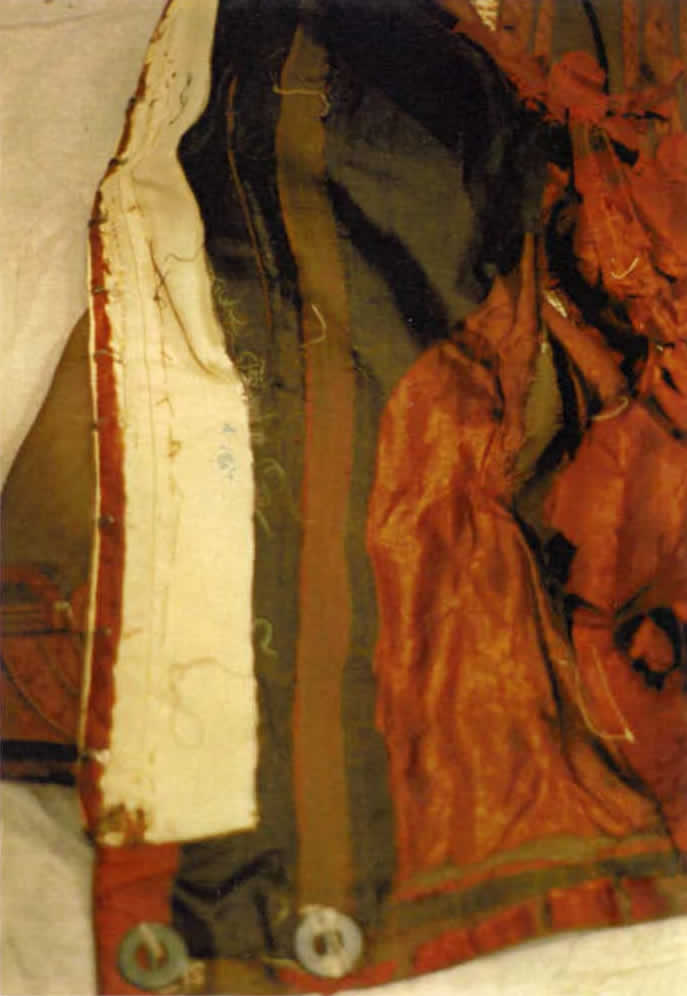 |
 |
The Sleeves
The sleeves are two-piece semi-fitted, with a decorative cuff. The elbow has ease in it. The cap of the sleeve has a fair amount of ease as well. The photo to the left below, labeled Figure 4, shows how the sleeve was cut to follow the curve of the arm. The ease in the cap is also visible. Figure 5 below shows fullness eased into the elbow.
The cuff is made in two pieces. The bottom piece which wraps around and overlaps, and the top piece which wraps around and butts together. The two pieces are attached and then stitched on top of the hem of the jacket sleeve, like a barrel cuff.
|
Figure 4: Profile with Sleeve Shape |
Figure 5: Detail of Elbow Showing Ease |
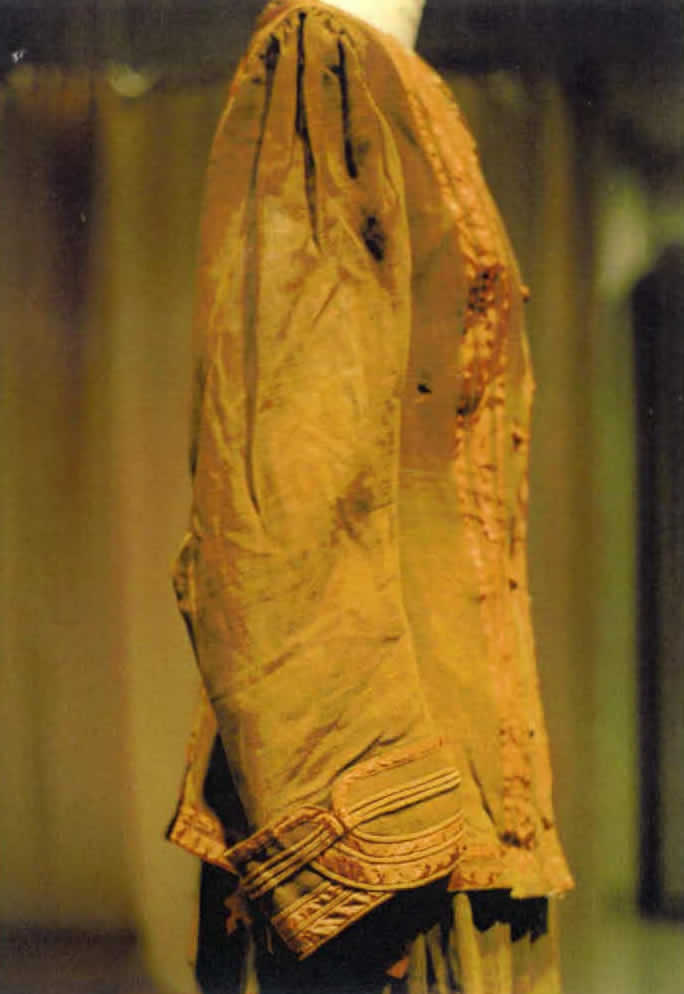 |
 |
The Skirt
The skirt , as seen in Figure 6, consists of three panels which are all straight grain rectangles. The center front panel is 28" in width and the two back panels are each 34" wide. The waist and hips of the skirt are shaped by knife pleats. Each is stitched down 17" from the waist. The pleats face away from center front around to center back, forming an inverted box pleat at center back. The box pleat conceals a placket closure of hooks and bars. The waist has been bound with a piece of black polished cotton, and a grosgrain ribbon has been stitched on top to hide the piping. There are two tucks around the lower edge of the skirt. The first is 12" up from the hem and is 1 1/2" wide. The second is 6" up from the hem and is 2" wide. The hem is 4" deep, being visibly stitched by machine; it has a braid trim attached to the inside at the edge.
Figure 7 below also shows the bias trim detail as well as tucks and hem. Each row of bias trim is approximately 5/8" wide. The first row is 6" up from the hem and rides along the top of the bottom tuck. A second row is placed 3/8" above this one. The third and last row of bias trim is 12" up from the hem and rides along the top of the upper tuck.
|
Figure 6: Waist of skirt at back |
Figure 7: Bottom edge of skirt |
 |
 |
Bodice Back Trim
Great care has been taken in applying the many areas of trim on this ensemble. The jacket in particular has been lavished with several rows of bias on the front and back. Starting in the center back there are two, 1/4" rows on each side of center back. There are also two symmetrical sets of three rows each that follow and hide the side back seams. These two sets continue into vents and end in points at the hem. The center row of each set is approximately 5/8" wide with 1/8" spaces between and 1/4" wide bands on either side of it. Two rows at center back stop short of neck line and hem to allow for a more decorative detail.
Starting at the side back seam there are two rows of bias at hem. One, 1/2" wide, which rides directly on hem. Then a second row is placed 1/4" wide and 1/4" above the first. Both continue around to the front.
A back detail, Figure 9 below, displays trim around the back neck edge. This continues from front edge. Two of the original total of 13 covered buttons on the jacket are missing from back detail, although one appears just below the center back neck edge.
|
Figure 8: Bodice Back |
Figure 9: Bodice Back Neck Edge |
 |
 |
Front Trim
There is a 5/8" bias extending up the front edge and around neck . At 1/4" away is another 1/4" wide piece of silk bias which runs along the wider bias. The 1/4" bias is shaped and stitched into small tabs every 3 1/2 to 4 inches apart. At each corner of each tab the bias is mitered and a covered button is decoratively placed at the end of each tab.
At the center front of the jacket and around the neckline a decorative flange has been added that butts together at center front. The flange is interfaced with a heavily stiffened linen and flat lined with ivory silk, over which a gold bullion ribbon has been applied . At the very edge, soutache has been sewn on to provide a clean edge. Silk yarn of light and dark brown have been woven through the bullion. The flange ends 2 3/4" from the hem.
Bias trim at the bodice hem breaks at side front, then continues and follows front edge mitering at the corner. Three bias rows follow and hide side front seams mimicking detail at side back.
|
Figure 10: Front bodice lower half |
Figure 11: Neckline detail |
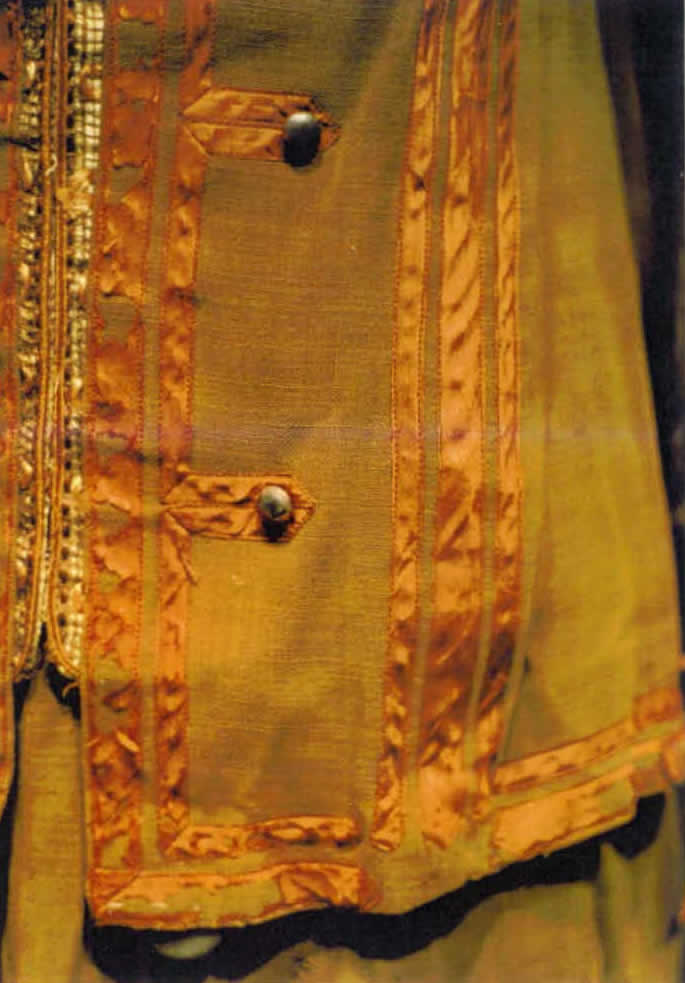 |
 |
Bias trim has also been applied to the cuff, in addition to soutache. There are two rows at the hem of the cuff approximately 5/8" and 3/8" in width, with soutache outlining and separating each one. The top piece of the cuff has three rows of soutache with 1/4" bias band around the top edge.
|
Figure 12: Cuff |
 |
Background
I've dated this dress around 1908-1910, because the silhouette of the dress is more relaxed than the previous decade. Corsets previous to 1908 were tight and constricting, forcing the body into an S-line. The photos below, reproduced from Waisted Efforts by Robert Doyle, are dated c. 1903.
|
Figure 13: Reproduced from Robert Doyle's |
Figure 14: Reproduced from Robert Doyle's |
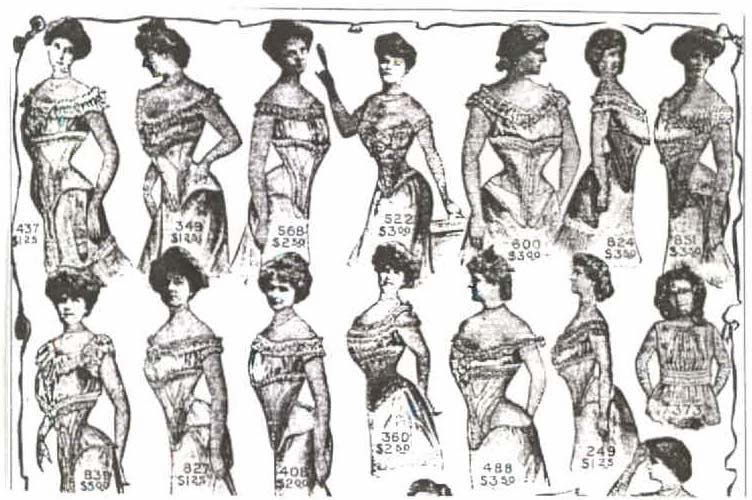 |
 |
By 1908 the corset becomes long and narrow. It moves below the bust and some extended as long as 17" below the waist. The photo at the left below, reproduced from The History of Underclothes by C. Willet and Phillis Cunnington, is a corset dated 1911. The photo on the right below, from Norah Waugh's The Cut of Women's Clothing, is dated 1912. It shows how the figure was more slender and straight, much like the two-piece dress I've researched. This dress is fitted over the figure, with a slightly high waist, the empire look being another characteristic of the time. The skirt also long and fitted, with pleats stitched down and then released just above the knee, to continue a slender line but allow for movement.
|
Figure 14: Reproduced from The History of Underclothes by C. Willet and Phillis Cunnington and dated c. 1911. |
Figure 15: Reproduced from Norah Waugh's The Cut of Women's Clothing and dated c. 1912. |
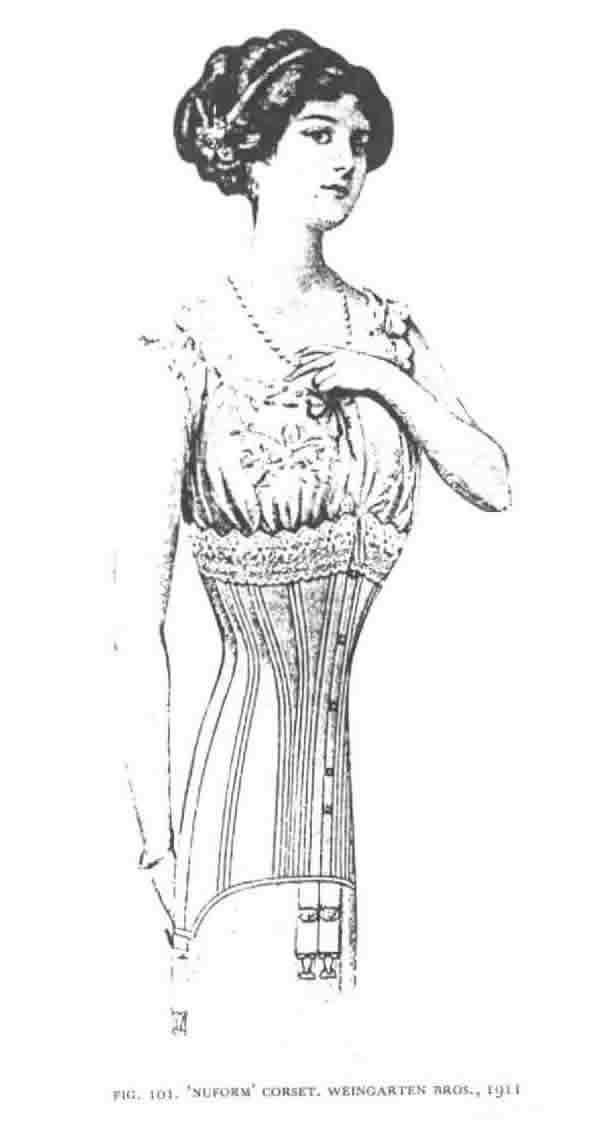 |
 |
© Marcy Linton, 2002
